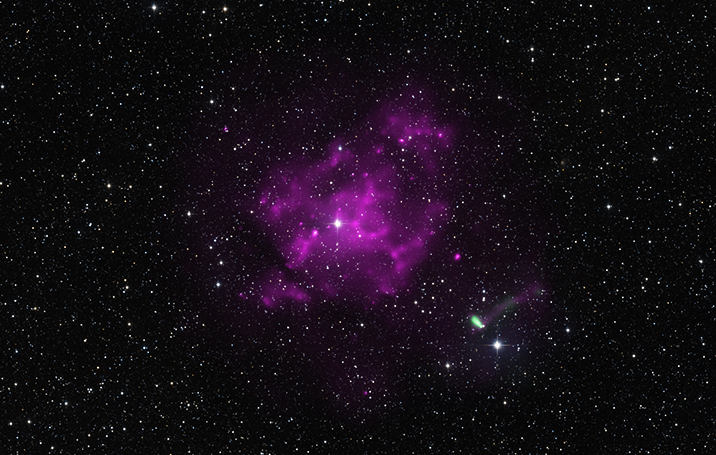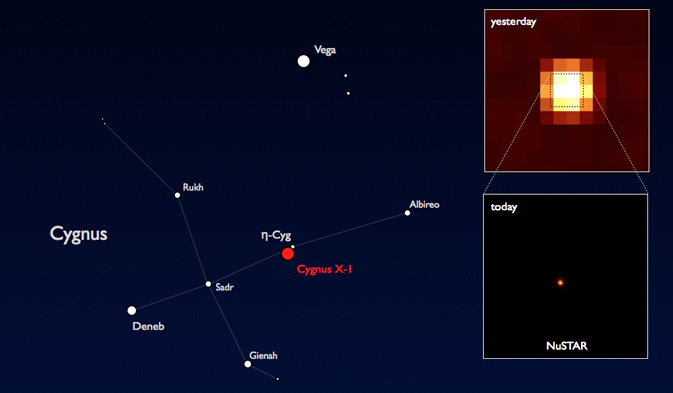How's my blogging? Leave some feedback, I get better at this, you get a more interesting read!
I thought I'd mention couple of bits of news that caught my eye during the week:
Neutron star clocked at nearly 3000 kilometres per second:
Remember how I said last post that some of the things that went on in a supernova explosion[1] were mysterious? Well, this is one of them: The supernova blast is set off by the creation of a neutron star[2], in a huge old stars collapsing core. The neutron star is in the middle of the 'bang'. So the explosion should push it equally in all directions, and end up not moving it very far at all.
Logical, yes?
Apparently not. Because a team effort, between the Chandra space telescope[3], the XMM newton[4] space telescope, and the Parkes radio telescope[5] in Australia, has found a record breaking oddity: A spinning neutron star, a pulsar, moving away from it's supernova at up to 2777 km per second. Or put another way, one hundred and seventy three times faster than the Voyager two[6] spacecraft, and about a hundred times faster than New Horizons[7].
Image above: A composite image. The purple cloud is still hot leftovers of a supernova. the little green thing on the lower right is the tail of high energy particles left by the speeding pulsar, with the pulsar itself right at its tip. Image courtesy of NASA / CXC / UC Berkeley / J.Tomsick et al / ESA / XMM-Newton.
Pulsars[8] are very odd things anyway: They are as dense as an aircraft carrier crushed into a pin head, they spin thousands of times per second, give out twin beams of high energy radiation, and have magnetic fields so strong they can bend atoms out of shape. That's just the beginning of their 'impossible, what's that then?' take on physics. Follow some of the links - it will disabuse you of the notion that we understand everything about how the universe works, if nothing else...
Video above: The pulsar wind coming off the Crab nebula pulsar. What you're looking at is a seething cloud of high energy particles, reaching into space at nearly light-speed. On the left is the view from the Chandra space telescope, on the right the view from the Hubble space telescope. Now imagine if the pulsar in the middle was going sideways, hundreds of times faster than any space ship.....courtesy of NASA/CXC/ASU/HST.
And this one is doing nearly a whole percent of light speed, sideways. And has tail three light years long behind it, made by the high energy particles (pulsar wind[9]) it emits. It's a nutjob speed demon, amongst extreme oddballs. The most likely explanation for this is that the supernova was somehow lopsided as it went off, but there are more exotic explanations. For example: The pulsars magnetic field may be able to produce a huge pulse of radiation to push the new neutron star[10], propelling it like an insanely powerful rocket.
We just can't be sure, the supernova birth of a neutron star is so utterly extreme...
Nu-STAR looks down the throat of a black hole:
Which is quite impressive, considering that black holes are black, and space is, um, black. But black holes guzzle stuff - gas, dust, giant planets - and guzzling is a messy process: The material getting swallowed first spins very, very, fast around the hole, heating up enough to emit X-rays[11].
Which is where Nu-STAR[12] comes in:
Nu-STAR, the fridge sized space satellite that transforms into a ten meter long X-ray telescope, with the most accurate X-ray detection system ever sent into space, has begun taking it's first images:
Image above: Nu-STAR christens its optics by turning X-rays from gas falling into a black hole into the sharpest X-ray photo ever. Image courtesy of NASA/JPL-Caltech
Fittingly, for a week when I'm obsessed by supernova and neutron stars, Nu-Stars first ever picture is of Cygnus X-1, the nearest black hole to Earth[13]. By nearest, I mean a comfortable 300 light-years away, so don't panic, and no-one start yet another doomsday cult.
Unless it's a cult of beer down the pub to celebrate Nu-STARs success, in which case I'm in, oh great and holy one.....
By the way: I'm trying to finish off a paper, whilst arranging a house move. I can't recommend the experience, it's bloody exhausting. So please accept my apologies if my posts tend to the brief side over the next few days!
List of links:
[1]http://www.space.com/6638-supernova.html
[2]http://science.nationalgeographic.com/science/space/solar-system/neutron-stars/
[3]http://chandra.harvard.edu/
[4]http://xmm.esac.esa.int/
[5]http://www.parkes.atnf.csiro.au/
[6]http://voyager.jpl.nasa.gov/
[7]http://www.nasa.gov/mission_pages/newhorizons/main/index.html
[8]http://csep10.phys.utk.edu/astr162/lect/pulsars/pulsars.htm
[9]http://en.wikipedia.org/wiki/Pulsar_wind_nebula
[10]http://iopscience.iop.org/0004-637X/728/2/75/fulltext/apj_728_2_75.text.html
[11]http://csep10.phys.utk.edu/astr162/lect/blackhole/blackhole.html
[12]http://www.nasa.gov/mission_pages/nustar/news/nustar20120628.html
[13]http://hyperphysics.phy-astr.gsu.edu/hbase/astro/blkbin.html]


No comments:
Post a Comment